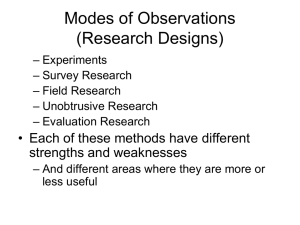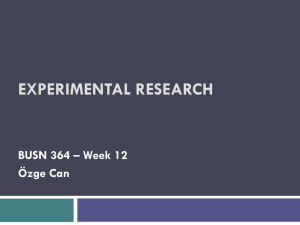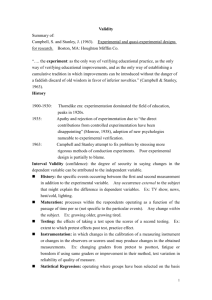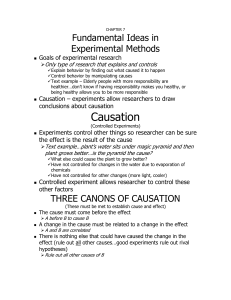PowerPoint
advertisement
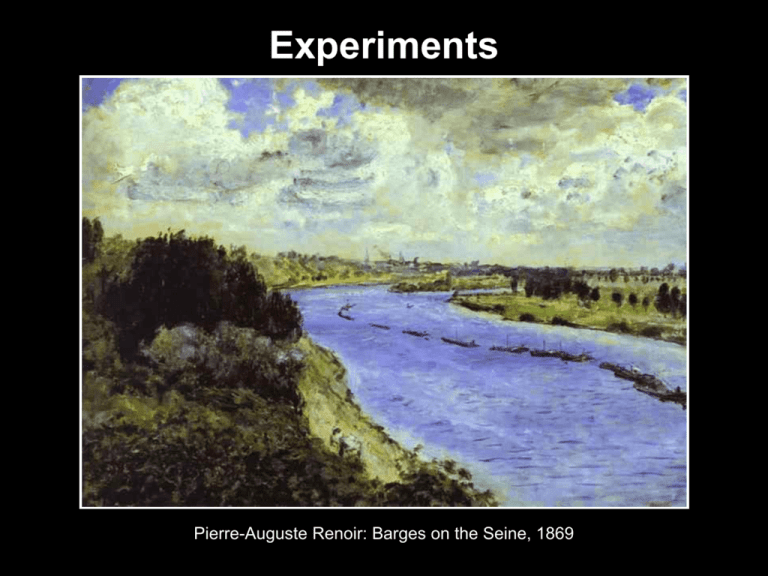
Experiments Pierre-Auguste Renoir: Barges on the Seine, 1869 Topics Appropriate to Experiments 1. Experiments Allow for Control of Variables • How much is learned about a topic. • How much time is allowed for tasks. • The composition of groups. • Who speaks and how long they speak in groups. • Manipulation of opinions by the use of confederates in group settings. 2. Laboratory and Field Experiments • Field experiments provide a natural setting, but allow for less control over variables. The Classical Experiment 1. Independent and Dependent Variables • Typically, the operational definitions of independent and dependent variables are defined prior to the experiment. • The way in which independent variables will be introduced into the experiment is predetermined. • The purpose of an experiment is to manipulate the score on the dependent variable by introducing different independent variables or manipulating existing ones. The Classical Experiment 1. Independent and Dependent Variables (Cont.) • Included among the independent variables are one or more variables specifically intended to manipulate the score on the dependent variable. • These are called by various names, each meaning the same thing: • Stimulus • Treatment • Experimental The Classical Experiment 2. Pretesting and Posttesting • The pretest is the measurement of variables prior to introducing the treatment variable. • The posttest is the measurement of variables after introducing the treatment variable. 3. Experimental and Control Groups • The Experimental group is exposed to the treatment variable(s). • The Control group is not exposed to the treatment variable(s). The Classical Experiment Experimental Group Control Group Time 1 Measure Dependent Variable (pretest) Measure Dependent Variable (pretest) Time 2 Administer Stimulus Time 3 Measure Dependent Variable (posttest) Schedule Measure Dependent Variable (posttest) The Classical Experiment 4. The Blind Experiment • In some cases, the experimenter might influence the scores on the variables. • Example: In evaluating the efficacy of a new medicine, if the subjects know they are taking the medicine, they might respond because of this knowledge rather than because of the medicine. Therefore, all subjects are given “medicine,” but the control group is given a placebo: a false medicine (e.g., a pill filled with sugar rather than medicine.) The Classical Experiment 5. The Double Blind Experiment • In some circumstances, the experimenter might influence scores on the variables. • Example: If the experimenter knows which subjects are taking the real medicine and this person wants the medicine to be effective, then the experimenter might evaluate the subject’s outcomes more favorably. • In the double-blind experiment, neither the subject nor the experimenter know which subjects are in the experimental group. Selecting Subjects 1. Representation • Typically, experiments focus on building or testing theory rather than attempting to predict population characteristics. • Therefore, as long as the subjects have key characteristics of interest, then it is not often necessary that the sample be representative. • It is critical, however, for subjects to be evenly matched in characteristics across the experimental and control groups. Selecting Subjects 2. Probability Sampling • Probability sampling is used to achieve representativeness with large samples. Therefore, it is not often used for experiments. 3. Randomization • It is essential for subjects to be randomly assigned to the experimental and control groups. 4. Matching • To assure even distribution of key characteristics between groups, experimenters might assign subjects to groups. Quasi-Experimental Designs 1. Rationale • Sometimes, the researcher examines events in the field that cannot be easily anticipated. • Responses to disasters. • Responses to rapid social change. • Sometimes, the added expense of a classical experiment is not necessary. • The one-shot case study is common to market testing of low-involvement products. Quasi-Experimental Designs 2. One-Shot Case Study • Posttest only of the experimental group. Schedule Experimental Group Time 1 Time 2 Administer Stimulus Time 3 Measure Dependent Variable (posttest) Control Group Quasi-Experimental Designs 3. One-Group Pretest-Posttest Design • Pretest and posttest of one group. Schedule Experimental Group Time 1 Measure Dependent Variable (pretest) Time 2 Administer Stimulus Time 3 Measure Dependent Variable (posttest) Control Group Quasi-Experimental Designs 4. Static Group Comparison • Control at Time 3. Schedule Experimental Group Control Group Time 1 Time 2 Administer Stimulus Time 3 Measure Dependent Variable (posttest) Measure Dependent Variable (posttest) Experimental Designs This chart summarizes the experimental designs: Control Group Yes No Yes Classical One-group, Pretest-Posttest No Static-Group Comparison One-Shot Case Study Pretest Validity Issues in Experiments 1. Sources of Internal Invalidity • Do the results reflect the effect of the stimulus variable? • Factors affecting internal validity: 1. History: Unplanned events that occur during the experiment. 2. Maturation: Change in people from Time 1 to Time 3. 3. Testing (cueing): The process of the experiment itself creates changes in the dependent variable. Validity Issues in Experiments 1. Sources of Internal Invalidity (Continued) • Factors affecting internal validity: 4. Instrumentation: Do the pretest and posttest measures exactly match each other? 5. Regression Toward the Mean: Changes might occur because subjects begin at the extreme. 6. Selection Bias: Subjects are not matched across groups. Validity Issues in Experiments 1. Sources of Internal Invalidity (Continued) • Factors affecting internal validity: 7. Experimental Mortality: Subjects drop out of the study before it is completed. 8. Causal Time Order: In some cases, it is difficult to time the stimulus after the pretest. 9. Diffusion: Subjects across groups share information with one another. 10. Compensation: Experimenters might treat the control group differently. Validity Issues in Experiments 1. Sources of Internal Invalidity (Continued) • Factors affecting internal validity: 11. Compensatory Rivalry: Subjects who know they are in the control group might behave with more interest. 12. Demoralization: Subjects in the control group might behave with less interest. Validity Issues in Experiments 2. Sources of External Invalidity • Can the results be generalized to the population? • Interaction: Subjects who know they are being studied might be more receptive to the stimulus. • Cueing: The administration of the pretest might sensitize subjects to the content of the stimulus. Alternative Experimental Settings 1. Web-Based Experiments • Subjects answer questions or perform tasks online. • Subjects might be asked questions prior to being assigned to a group, or they might be assigned at random at the outset of their session. See: Online Social Psychology Studies See: Small World Phenomenon Alternative Experimental Settings 2. Natural Experiments • Behavior occurring during or after natural events can be investigated. • “Control” groups can be persons in similar settings that did not experience the natural event.
